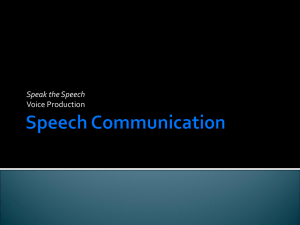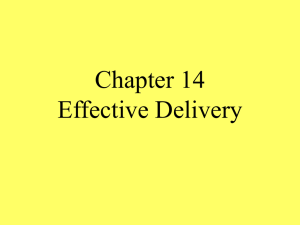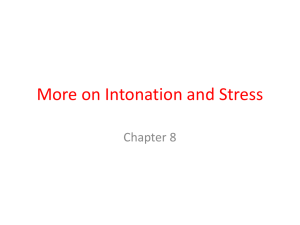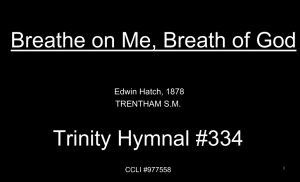Developing your Voice
advertisement
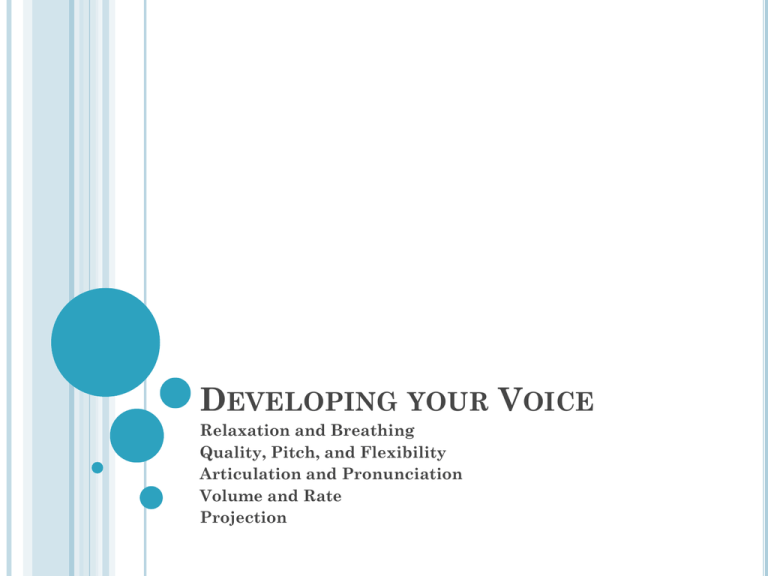
DEVELOPING YOUR VOICE Relaxation and Breathing Quality, Pitch, and Flexibility Articulation and Pronunciation Volume and Rate Projection RELAXATION Freedom from all bodily tensions Gives the actor a deeper level of awareness and provides the energy needed for the stage. Relaxation will give you physical and mental control and focus onstage, which will help you achieve your theatrical goals. Relaxation will also improve your posture (how you sit and stand.) Good posture is essential in controlled breathing. BREATHING The necessary process of inhaling and exhaling air to live. Controlled breathing gives the performer enough power to carry the voice and be clearly heard. Onstage you need to inhale more deeply than you do in regular breathing, which translates into using more muscles. Allows you to build volume and vary your vocal sounds without running out of breath or straining your voice. Exhaling should also be stronger & with more control that in your everyday breathing. BREATH CONTROL It is how much force you use in inhalation and exhalation. Diaphragm: the muscle located between the rib abdomen and the rib cage. Must be used to supply the air you need to create sound. Breath control helps: Develop an effective voice onstage & provide the support you need to sustain you through performances. Influences the body and its movements. RELAXATION & BREATHING ACTIVITIES Musical Relaxation HA!HA!HA! Slowly inhale and hold your breath for 10 counts. Exhale on the sound of “Ha” AH!!!!! Lie on the stage and relax to the soothing sounds of the music. Starting from your head all the way down to your toes. Slowly inhale and hold your breath for 10 counts. Exhale on the sound of “Ah” Snake Slowly inhale and hold your breath for 10 counts. Exhale on the sound of “Sssssss” QUALITY Quality: is the voice element that makes you sound different from everyone else. You don’t have much choice about your voice, but you can eliminate annoying habits. Ex. Huskiness, nasality (sounds produced by allowing your breath to pass through your nose when you talk). As an actor, you must use a variety of voice qualities to interpret or portray different characters. Quality reflects emotion! PITCH Pitch: the musical tone of your voice- or how high or low you speak using a musical scale. Pitch is determined by the vibration of the vocal folds. Vocal folds: muscular membranes in the larynx that produce sound. The faster the folds vibrate the higher the pitch. The slower the folds vibrate the lower the pitch. Swollen vocal folds cause a hoarse & low pitch voice. Ex. After yelling at a football game. Everyone is born with a certain pitch. Nothing can be done to change it, but you can manipulate it. INFLECTION 2 common flaws on stage are high tone & monotone. A high, thin pitch can be corrected with concentration and a conscious effort to lower your speaking tone. A person who is monotone, needs inflection! Inflection: the rising and falling of pitch. Inflection adds meaning, color, and rhythm to spoken words. FLEXIBILITY Flexibility: the result of using the muscles in your face, tongue, jaws, lips, and throat in a lively manner. Process of varying inflections as you speak. Flexibility is created in a variety of ways: Using a variety of sounds in the words Placing emphasis or stress on certain words/syllables. Phrasing words of sentences in a certain way. Using pauses. Poise: the effective control of all voice elements and body movements. ACTIVITY! Quality: Emotional Survey Using different emotions, say these words: yes, no, it’s okay, finally, sure, great. Suggested emotions are: happy, sad, fearful, angry, and jealous. Pitch: What did you say: Using gibberish (senseless chatter) and varying the inflection in your voice. Flexibility: It’s a date! Divide into pairs, a girl and a boy. Carry on a conversation asking for a date, using only the first names as the dialogue. Vary your inflection for emphasis and interest. ARTICULATION Articulation: the shaping and molding of sounds into syllables. We use all our articulators Lips, tongue, teeth, hard & soft palates, jaws, muscles, and nasal passageways. You need to practice articulation daily. Articulation drills include tongues twisters to not only improve your articulation on stage, but also train your ear to hear how you sound in everyday life. PRONUNCIATION Pronunciation refers to the way words are said. Proper pronunciation means that words are spoken according to dictionary notations. Diction: a person’s pronunciation of words, choice of words, and manner in which the person expresses himself or herself. Dialect: is a pronunciation of words from different languages blended together to form a distinct language for a group of people. Accent: is the manner in which people speak; it is the way words are pronounced in different parts of the world. ACTIVITY Articulation: Tongue Twisters! Pronunciation: Pronunciation check. Check your pronunciation of certain words that are often mispronounced. VOLUME Volume: how loudly or softly you speak. Basis for a person’s volume is breath control. Proper voice placement is necessary! ( directing the voice where the audience is located). Shouting is NEVER the answer It is YOUR responsibility, as an actor, to train your voice for adequate volume. RATE Rate: is the speed at which you speak. Rate and volume affect each other. Many actors mispronounce and slur their words when they talk too fast. Rate is one of the elements of voice that can be effectively used for characterization. You must give your audience time to listen and think about what they hear. You must control articulation if necessary to speak at a faster rate. Always remember that it is the audience’s first time & probably last time to see and hear the performance. ACTIVITY! Volume: Counting the 5s. Count slowly by 5s increasing your volume with each number. Read a passage in a variety of places. For example, begin reading to a small group, next in front of the entire class, then move to a cafeteria or auditorium, and finally read outside to a group. Rate: Watching Time Go By. Using the second hand on a watch, time yourself counting. Count from 1-5 in 5 seconds, 1-10 in 10 seconds, 1-20 in 20 seconds. Learn to control your rate when you speak. Repeat the drill and ask a classmate to listen to your rate. Experiment with speaking at various rates. Have the volunteer suggest your best rate of speaking to be easily understood. PROJECTION Projection: is the placement and delivery of all the characteristics of an effective voice to communicate with your audience. Projection involves directing your voice at a directed target. Involves delivering your lines to the audience. Proper and effective projection requires that you want to speak and perform well. ACTIVITY Projection: Outdoor Theatre? Select a short monologue and read or memorize the monologue and present it outside, with the class as the audience. Focus on the placement and delivery of your lines. How far can you project? Lie on your back with a book on your abdomen and use projection to say a sentence clearly and loudly!
